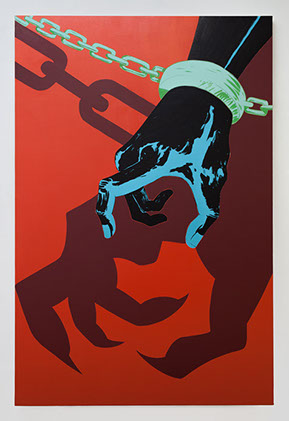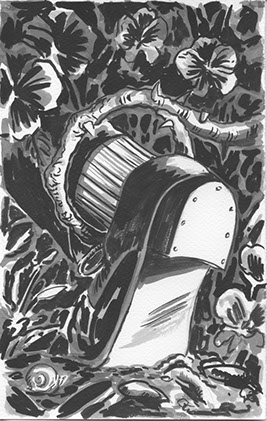Mark Thomas Gibson at BU: American Conquest of Alternative Fine Art
By Simone Migliori
In a stuffy room, hidden in the labyrinth of studios at Boston University’s 808 Gallery, fifty students and faculty from the greater Boston area sat in waiting. Some crammed into hard plastic chairs, while others leaned in faux apathy against the walls.
Sketchbooks spread to fresh pages and dripping fountain pens poised, they sat in waiting for the arrival of Mark Thomas Gibson—NYC comic artist, assassin of fine art criterion, and guest lecturer for BU’s Tuesday Night MFA Lecture Series Gibson arrived clad in all black—from thick framed glasses to dusty boots to ink-stained fingers. The sober look was shattered instantly by his bubbly laugh and the passionate energy that exuded from his person.
Gibson’s artwork, a mix of chaotic black-on-white sketches, larger-than-life funk-pop gore and horror creations reflects the psychological impact of our political climate and the troubling truths buried beneath the mythology of heroism masking American history.
“This consistent thing that happens over and over again in America [is] where we find a way to become the victim,” Gibson said.
Nowhere is this concept more clearly illustrated than in Gibson’s feature comic work, Some Monsters Loom Large. The main character, a wolf-man, is led on a violent journey to discover the truth behind the creation of his world, an allegory for the founding of America.
Gibson’s fascination with American history began when his mother, a Texas native, drilled the importance of history into him from a young age, namely the Battle of the Alamo. In graduate school, Gibson began to seek out the truths that are clouded behind America’s founding mythology, and discovered that many of the heroes and martyrs of these stories were anything but. Through his research, Gibson learned that America’s notorious founders, the Pilgrims, cannibalized Native American corpses for sustenance in the winter.
In Some Monsters, the truth behind the Pilgrims’ first footsteps on North American soil is presented in gritty detail to the wolf-man.
“This idea of consuming people…of using [Native Americans] as a resource starts in the first interaction,” Gibson said. “That idea of the Manifest Destiny monster transforming into a giant hungry ghost that can never be satiated…. that’s [a] virus, [that’s] what makes the werewolf.”
Gibson’s profound artistic interpretation of American colonization and the mass genocide of Native American people is at the controversial heart of Some Monsters. The comic’s uninhibited gore and terrifying imagery evokes disbelief and horror—exactly the response he sought from his viewers.
“Yeah, it’s frustrating…and it’s history!” Gibson said.
The most gripping aspects of Some Monsters are Gibson’s comparisons. He compares Manifest Destiny, a foundational component of American cultural identity, to a virus. Likewise, Gibson makes a comparison of the colonizing white men to werewolves—his childhood fear.
“With werewolves, it’s trauma. They rip you apart and then [inflict] this trauma on someone else,” Gibson said. “We still have this colony mentality. It’s a virus.”
Peter Negri, a senior at Massachusetts College of Art and Design who attended the event, found Gibson’s work to be “graphic.” “He’s referencing the history [that] people forget, and making his own history along the way,” Negri said.
Gibson’s history began in his hometown of Florida in 1980. As an undergraduate, Gibson studied at Cooper Union College. He then went on to receive his MFA in Painting & Printmaking from Yale University. Now, he splits his time between New York City and New Haven, Connecticut, where he teaches art classes at Yale.
Though drawing is his core passion, Gibson said he began painting after a high school art teacher told him he would never be good at it.
His most recent exhibit, a series of large-scale neon-bright paintings adapted from his second book, Early Retirement, were featured in New York City’s Fredericks & Freiser Gallery this spring.
The paintings, Gibson said, require 4 days of prep work in the studio. He then spends twenty-four hours at a time engrossed in creating. Despite his colorblindness in one eye, he is intent on incorporating colors into his large-scale pieces, no matter how grueling the process. With one eye squinted, he identifies and labels the colors for their specific use in each piece.
BU graduate student and event attendee Victoria Nunley is a longtime fan of Gibson’s work, particularly his platform and the difficult topics he tackles. “He takes high ‘fine’ art, and consumer platform art, and [places] an equalizing act on it,” Nunley said of Gibson’s Fredericks & Freiser exhibit.
Recently, Gibson took a break from his art to co-curate a show called Black Pulp! with his colleague William Villalongo. Black Pulp!, exhibited at Yale’s traveling art gallery, utilizes media and art to showcase the evolution of black identities in the United States.
At the moment, Gibson is waiting for his next spark of inspiration to strike.
“I carry around a little sketchbook and jot down ideas,” he said.
Gibson’s fans eagerly anticipate his next work to horrify, strike awe, and inspire in the otherworldly, haunting style that has attracted such a following.
Says Negri, “he’s got his foot on the gas pedal, a lot on his mind."
Images courtesy of markthomasgibson.com



